Managing various AWS resources can be challenging since a single misconfigured service can degrade performance or increase costs. This makes it difficult to identify issues without effective monitoring.
Monitoring AWS environments ensures your applications function correctly and efficiently. Key benefits include:
- Faster Issue Detection and Resolution: Monitoring tracks application health and triggers alerts for potential issues, enabling quick resolution and minimizing downtime.
- Optimized Resource Utilization: Tracking CPU, memory, storage, and network metrics helps you allocate resources efficiently, scale based on demand, and reduce costs by identifying underused or over-provisioned resources.
- High Availability: Monitoring critical components ensures system reliability and helps meet service level agreements (SLAs) by detecting and resolving issues before they impact availability.
- Enhanced Security and Compliance: Monitoring security metrics, such as access logs and configuration changes, helps detect threats, improve security posture, and ensure compliance with industry regulations.
In this article, we have listed down two categories of AWS monitoring tools:
- AWS native monitoring tools.
- Third-party monitoring tools.
AWS Native Monitoring Tools
AWS provides several built-in monitoring tools, each designed for specific use cases. These include Amazon CloudWatch, AWS CloudTrail, AWS Config, Amazon X-Ray, Amazon Inspector, and AWS Security Hub.
Key benefits of using AWS native monitoring tools:
- Seamless integration with AWS services for quick telemetry setup
- Built-in security and compliance features
- Automated monitoring and alerting
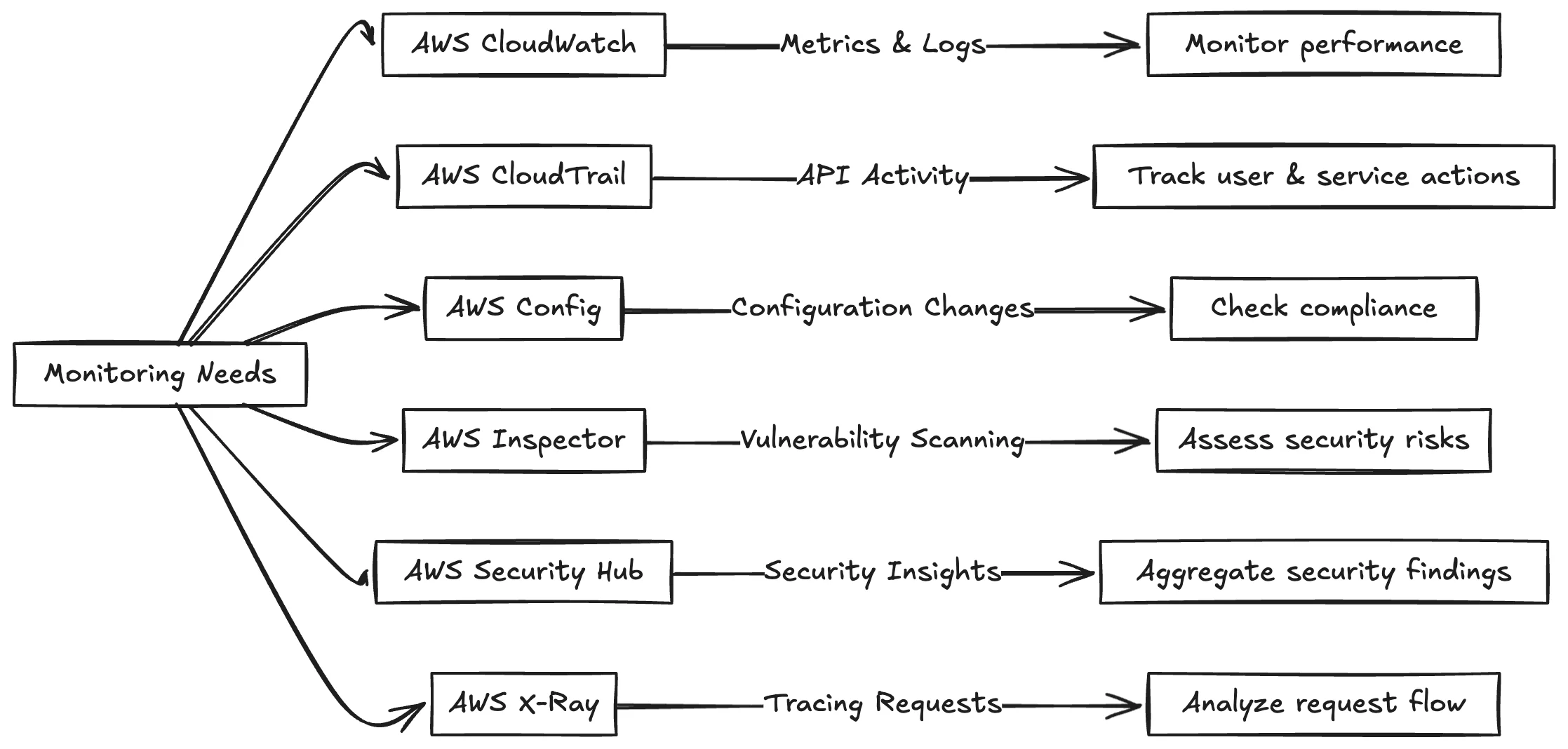
1. AWS CloudWatch
Amazon CloudWatch is a native AWS monitoring service that collects and tracks metrics, logs, and events across AWS resources. AWS services send data directly to CloudWatch, providing a centralized view of infrastructure and application performance.
Key features:
- Track resource utilization and performance metrics (CPU, memory, network, and custom metrics) in real time.
- Search and filter logs using CloudWatch Logs Insights for real-time log pattern analysis.
- Set metric thresholds to trigger CloudWatch Alarms to send notifications or run automated actions. Use CloudWatch Events to respond to changes or schedule tasks automatically.
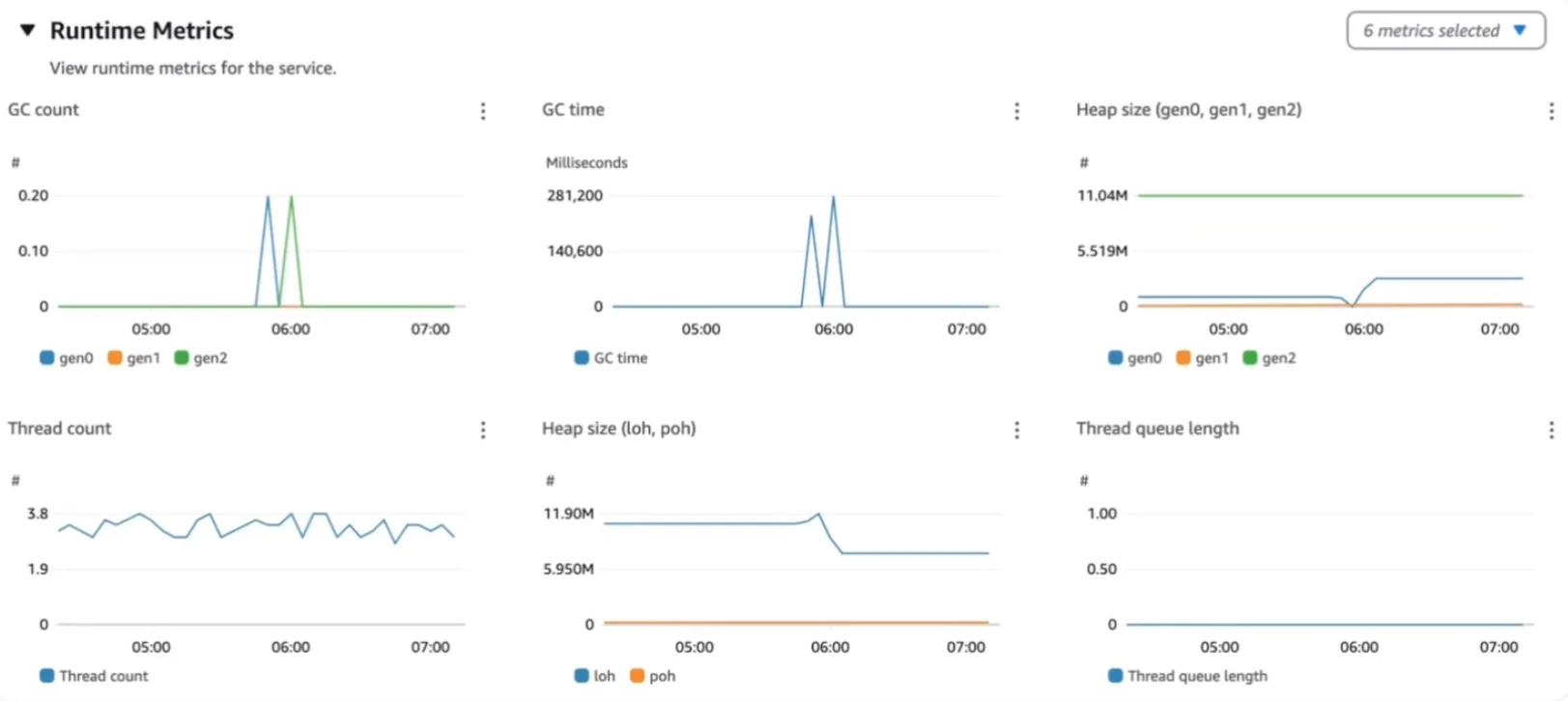
CloudWatch integrates seamlessly with most AWS services. It automatically receives metrics and logs without requiring additional setup. You can also connect CloudWatch with other services, such as AWS Lambda or Amazon SNS, to trigger responses to alarms or events.
Pricing
CloudWatch follows a pay-as-you-go model based on usage. Key cost factors include:
- Number of Basic and Custom monitoring metrics.
- Number of API requests.
- Number of Custom dashboards and Alarm metrics.
The free tier includes 10 custom metrics, 5 GB of log data ingestion, and 3 dashboards. However, costs can increase with high-volume monitoring or fine-grained (1-second) metrics. For more information, refer to CloudWatch pricing.
Pros
- Easily enabled with minimal setup and monitors a wide array of AWS services and resources by default.
- Built-in alerting and automated event actions to support quick responses to issues.
- Only pay for what you use; can be cost-efficient for moderate monitoring needs.
Cons
- Limited visibility into on-prem or multi-cloud resources. Since, CloudWatch focusses on AWS, so external data requires custom integration.
- Dashboards are functional but compared to some third-party tools might feel less customizable.
- CloudWatch costs can become significant with high metric counts, high log volumes, or detailed metrics if not carefully managed.
Ideal Use Cases
Best for AWS-centric environments needing out-of-the-box monitoring of AWS services. Ideal for teams who want a simple, no-frills solution integrated into AWS for basic infrastructure monitoring and alerting. CloudWatch is a good default for AWS resource monitoring and for startups or small teams who primarily use AWS and want to avoid third-party tools and data egress.
2. AWS CloudTrail
AWS CloudTrail records account activity and API calls across your AWS environment. It captures who did what, when, and from where, offering detailed visibility into user activity for auditing and compliance.
Key features:
- Records API calls made through AWS Management Console, SDKs, command line tools, and other services.
- Stores event history in Amazon S3 for secure, durable, long-term access.
- Supports integration with Amazon CloudWatch Logs for near real-time alerting on specific activities.
- Enables tracking of changes to resources, user access, and operational actions.
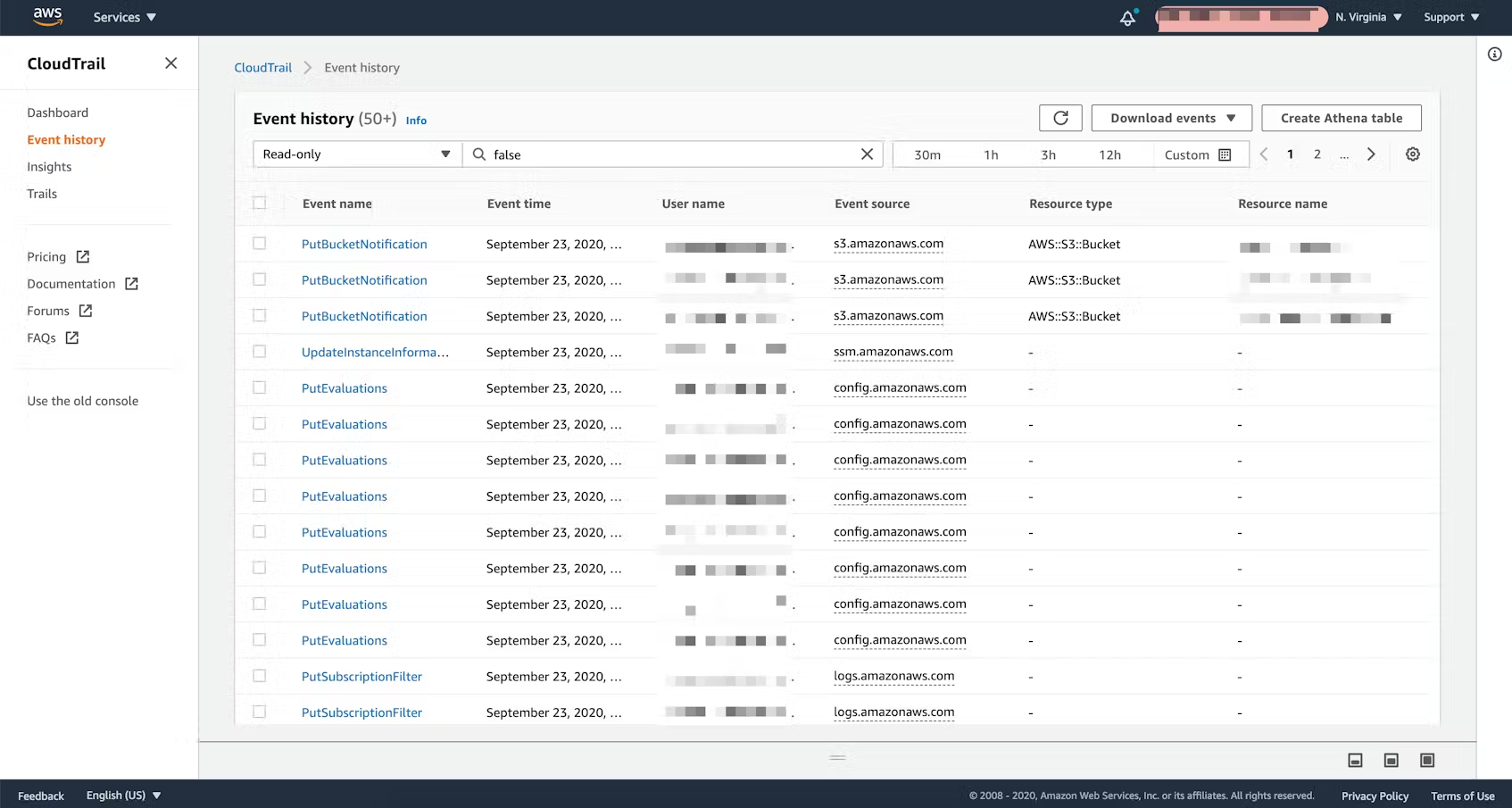
Pricing
CloudTrail provides a free tier that includes management events for the last 90 days. Additional charges apply for:
- Data events (e.g., S3 object-level operations, Lambda executions).
- CloudTrail Lake queries and storage.
- CloudTrail Insights.
For more information, refer to CloudTrail pricing.
Pros
- Provides audit trails for security, governance, and compliance.
- Enables traceability for user and service actions across AWS.
- Supports long-term retention of log
Cons
- CloudTrail Insights takes ~36 hours to detect anomalies. This makes CloudTrail not ideal for real-time monitoring.
- Requires integration with other tools (e.g., CloudWatch, AWS Athena ) for advanced queries and alerts.
Ideal Use Cases
Best suited for AWS environments where tracking user activity and API calls is essential for auditing, compliance, or security investigations. Ideal for security, DevOps, or governance teams who need to understand who did what, when, and from where across services.
If you want a native AWS solution to maintain a reliable audit trail, CloudTrail is a good solution.
3. AWS Config
AWS Config is a configuration auditing tool that tracks AWS resource configurations and changes over time. It helps you understand how resources are related and whether they comply with your internal rules or industry standards. While CloudTrail logs who made a change, Config verifies whether the change follows policy rules.
Key features:
- Automatically records resource configurations and changes.
- Supports predefined and custom rules for compliance assessments.
- Enables visual resource relationships with configuration timelines.
- Integrates with AWS Systems Manager and AWS Organizations for multi-account reporting.
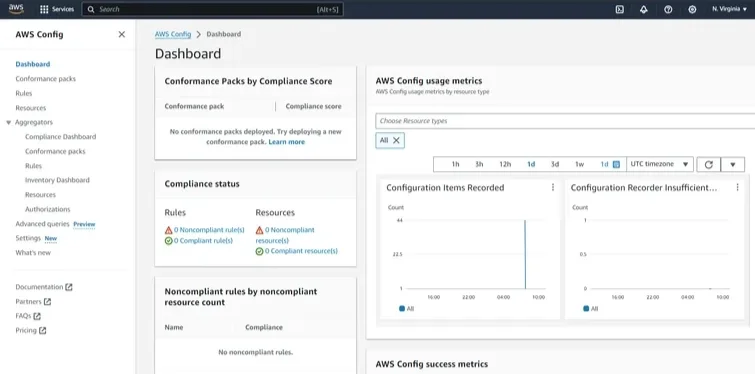
Pricing
You are charged based on the following:
- Number of configuration items recorded.
- Number of active AWS Config rule evaluations.
- Number of conformance pack evaluations in your account.
Additionally, you can also select:
- Amazon Simple Storage Service (S3) bucket configuration.
- Amazon Simple Notification Service (SNS) to send configuration change notifications.
For more information, refer to AWS Config pricing.
Pros
- Identifies security impacts across connected resources.
- Tracks historical changes for troubleshooting and auditing.
- Integrates with other AWS security and governance tools.
Cons
- You have to configure it separately for each AWS region.
- Focuses only on configuration-related security events.
- May incur additional costs in large environments with many configuration changes.
Ideal Use Cases
Best suited for teams managing regulated workloads or internal governance standards who need to track how and when infrastructure changes over time. If you use AWS and want to detect changes, maintain compliance baselines, or troubleshoot changes, AWS Config is great solution.
4. AWS Inspector
Amazon Inspector is an automated vulnerability management service that scans your AWS workloads for software vulnerabilities and unintended network exposure. It provides detailed findings and mitigation recommendations.
Key features:
- Continuously scans EC2 instances and container images in Amazon ECR.
- Uses the Common Vulnerabilities and Exposures (CVE) database for risk scoring.
- Automatically prioritizes findings based on exploitability and exposure.
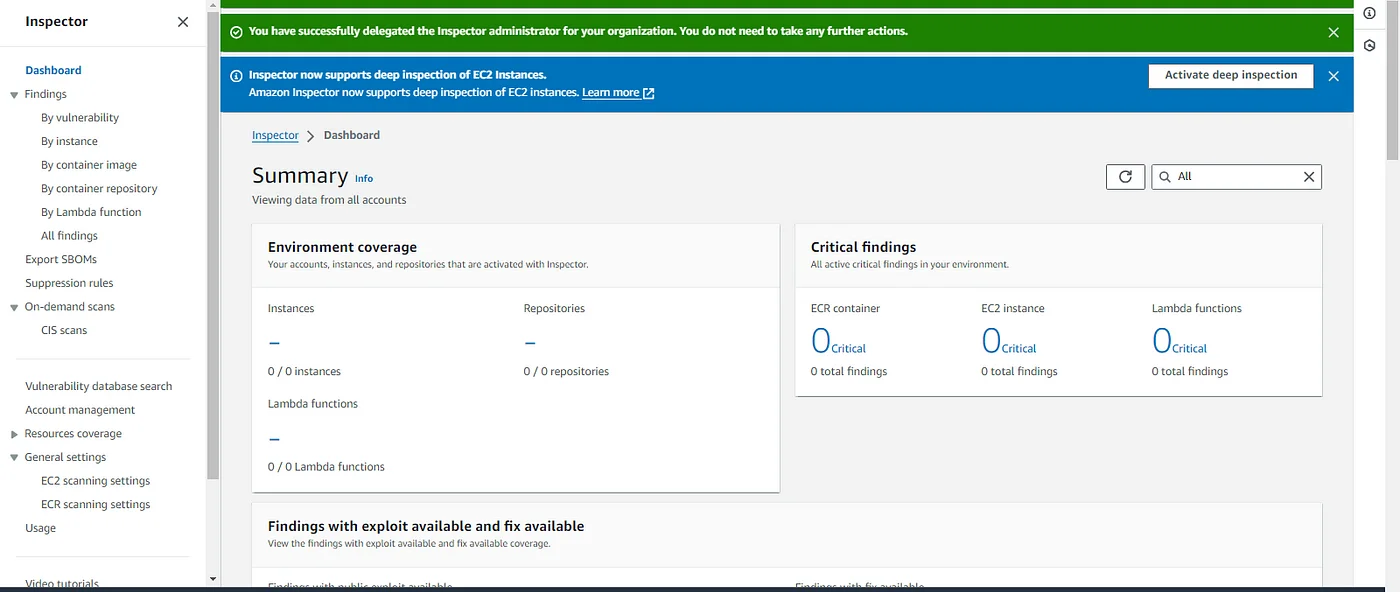
Pricing
Inspector pricing is based on:
- Number of EC2 instances scanned.
- Number of container image scans per month.
- Number of Lambda functions scans per month.
For on-demand container image scanning within CI/CD tools, you receive one-time free usage for 25 image assessments per account. Additionally, you can review estimated spend in the Amazon Inspector console to understand and estimate your paid usage.
For more information, refer to Inspector pricing.
Pros
- Automated security assessments: Continuously scans for vulnerabilities.
- Ranks vulnerabilities based on severity and reduces manual effort in security assessments
- Custom rules: Allows configuration of specific security checks.
Cons
- Limited to AWS-managed environments.
- May generate many findings that require tuning or filtering.
Ideal Use Cases
Best for AWS workloads requiring continuous vulnerability scanning and risk visibility across EC2 instances, Lambda functions and container images. Ideal for security or DevSecOps teams who want automatic CVE detection and risk scoring without external scanners.
If you already run workloads on AWS and want a native way to embed security checks into your deployment lifecycle, Inspector is a strong fit.
5. AWS X-Ray
AWS X-Ray helps you analyze and debug distributed applications, including those built using microservices and serverless architectures. It traces requests as they travel through your system providing insights into request flows, performance bottlenecks, and dependencies across microservices.
Key benefits:
- Captures detailed information about requests, latencies, errors, and traces.
- Helps identify performance bottlenecks or failure points in APIs, Lambda functions, and EC2 instances.
- Integrates with CloudWatch for monitoring and alerting.

image credit: AWS Blog.
Pricing
X-Ray pricing is based on:
- Number of traces recorded.
- Number of trace segments analyzed.
The free tier includes 100,000 traces and 1 million trace segments per month. For more information, refer to X-Ray pricing.
Pros
- Tracks requests across AWS services, containers, and on-premises apps.
- Automatically collects metadata across AWS services.
- Helps troubleshoot issues at the code level by identifying latency issues and error sources.
Cons
- Limited visibility for non-AWS services unless manually instrumented.
- Requires instrumentation of code to enable tracing.
- Focuses on performance tracing, not infrastructure metrics.
Ideal Use Cases
Microservice architectures on AWS needing distributed tracing to debug performance (e.g., tracing user requests through API Gateway -> Lambda -> DynamoDB, etc.). Ideal for developers of serverless apps or microservices who want to identify latency bottlenecks or errors across service boundaries. If you already use AWS and want a simple way to get distributed traces without introducing an external APM system, X-Ray is a strong fit.
6. AWS Security Hub
AWS Security Hub aggregates, organizes, and prioritizes security findings from AWS services and third-party tools. It provides a unified view of your security risks and compliance status.
Key features:
- Centralizes findings from AWS services like GuardDuty, Inspector, and third-party solutions.
- Supports AWS Foundational Security Best Practices and CIS AWS Foundations Benchmark.
- Provides insights across multiple AWS accounts and Regions.
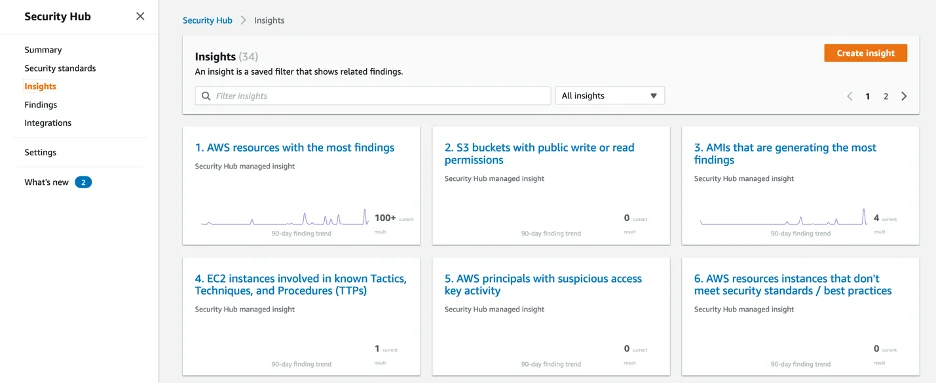
Image credit: AWS documentation.
Pricing
Security Hub pricing is based on:
- Number of security checks per account per Region.
- Number of ingested findings.
- Number of Automation rules.
For more information, refer to Security Hub pricing.
Pros
- Provides a centralized view of security posture.
- Automates compliance checks and security best practice validation.
- Supports multi-account and multi-Region environments.
Cons
- Does not generate findings itself; relies on integrated services. You must manually analyse telemetry by region.
- May duplicate findings if not properly filtered or deduplicated.
Ideal Use Cases
Ideal for security operations teams who need a single-pane view to track findings, automate remediation, and ensure continuous compliance. If you’re already using AWS-native tools like GuardDuty, Inspector, or Macie, Security Hub can act as a central aggregator to unify and act on all findings.
AWS Third-party Monitoring Tools
While AWS offers native monitoring tools, third-party solutions provide advanced capabilities and broader coverage, especially in multi-cloud or hybrid environments. Below is an overview of five prominent third-party AWS monitoring tools, including their key features and pricing.
1. SigNoz
SigNoz is an open-source application performance monitoring (APM) and observability platform. It provides a unified solution for monitoring logs, metrics, and traces. Built on OpenTelemetry and other open-source components, SigNoz offers developers and SREs a self-hosted alternative to commercial tools like Datadog.
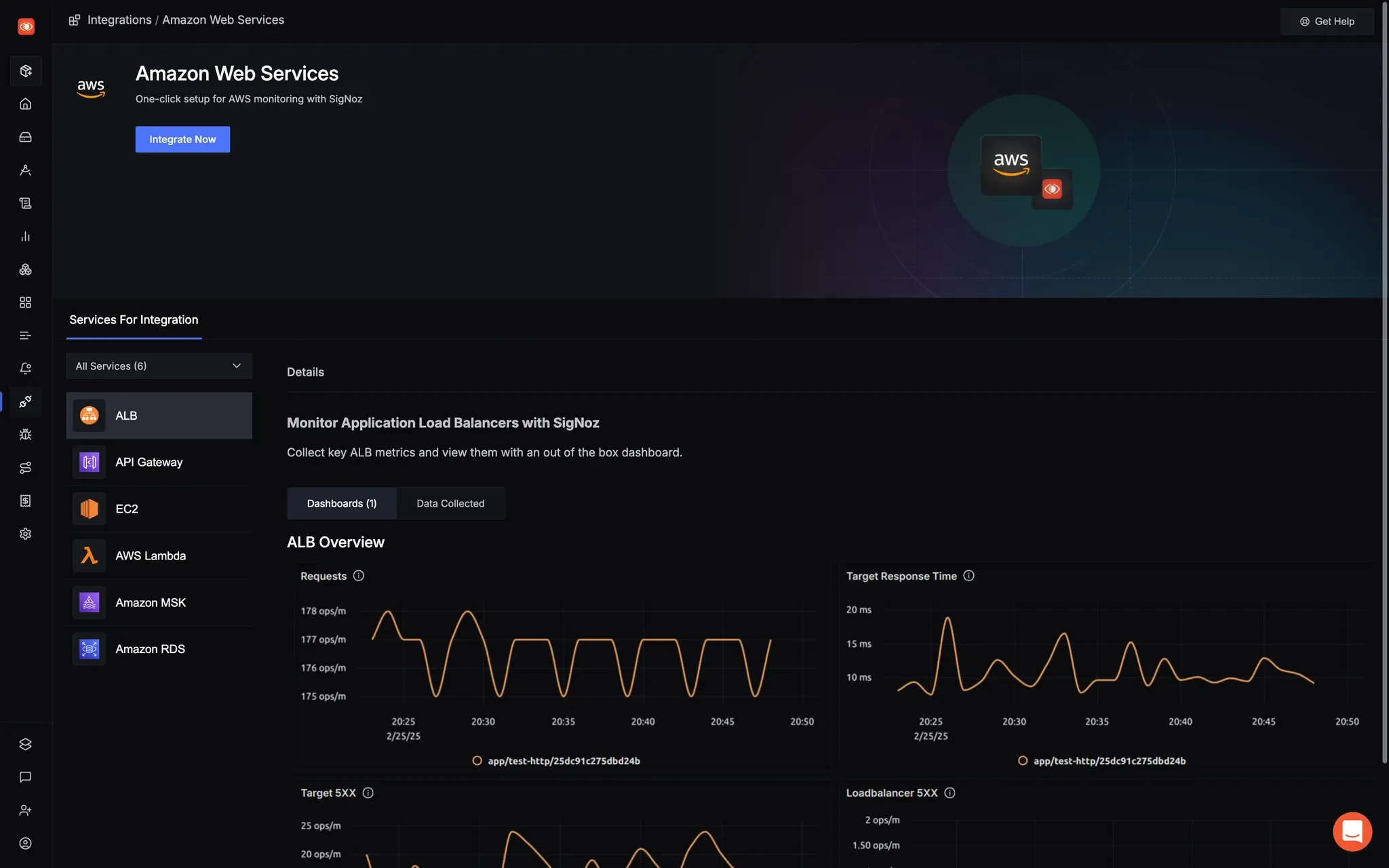
Image credit: SigNoz documentation.
Key features:
- Out-of-the-box AWS Integration: SigNoz can ingest telemetry from AWS services using the OpenTelemetry Collector with AWS-specific receivers (e.g., CloudWatch, X-Ray). You can deploy SigNoz on AWS (EKS or EC2) and monitor AWS-hosted workloads easily.
- Unified Observability: View logs, metrics, and traces in a single dashboard. For example, trace a request across microservices, inspect related logs, and monitor associated metrics without switching tools.
- OpenTelemetry Native: SigNoz uses OpenTelemetry standards for instrumentation. This ensures wide language and environment support.
- Log Management: Ingest application logs, search and filter them, and correlate logs with traces for deeper insights.
- Developer-Centric Experience: SigNoz offers a user-friendly UI and supports Docker-based installation. It also includes out-of-the-box dashboards for popular frameworks.
- Scalable Architecture: Built on ClickHouse and Kafka for high performance on commodity hardware.
For example, consider you have a web app hosted on AWS. It consists of frontend, backend and a database. You might integrate the following AWS services with SigNoz
| AWS Service | Purpose | Integration with SigNoz |
|---|---|---|
| Amazon ECS | Runs the Node.js backend | Instrument using OpenTelemetry SDK and export traces/logs to SigNoz |
| Amazon API Gateway | Manages public API endpoints | Export access logs to CloudWatch, then forward logs to SigNoz via the CloudWatch Receiver |
| AWS Lambda | Handles async tasks or light logic | Enable X-Ray tracing and send data to SigNoz using the AWS X-Ray Receiver |
| Amazon RDS | Manages the database | Monitor DB metrics via CloudWatch, then use CloudWatch Receiver to ingest into SigNoz |
| Amazon CloudWatch Logs | Collects logs across services | Use the CloudWatch Logs Receiver in the OpenTelemetry Collector to forward to SigNoz |
| AWS X-Ray | Tracing backend and Lambda | Use AWS X-Ray Receiver in the OpenTelemetry Collector to integrate with SigNoz |
You want centralized observability (logs, metrics, traces) using SigNoz. Your solution would be:

SigNoz cloud is the easiest way to run SigNoz. Sign up for a free account and get 30 days of unlimited access to all features.
You can also install and self-host SigNoz yourself since it is open-source. With 20,000+ GitHub stars, open-source SigNoz is loved by developers. Find the instructions to self-host SigNoz.
Pricing
SigNoz is free and open source when self-hosted. The software uses the Apache 2.0 license, so there are no licensing costs.
| Option | Description |
|---|---|
| Self-Hosted | Free. You only pay for infrastructure (e.g., EC2, EKS, ClickHouse storage). |
| Managed Service | Starts at $49/month (includes support and simplified deployment). |
Compared to SaaS tools like Datadog or New Relic that charge per host or per GB, SigNoz offers significant cost savings. You can sign up for a free account on SigNoz Cloud and get 30 days of unlimited access to all features. For more information, refer to SigNoz’s pricing.
Ideal Use Cases
SigNoz works best for:
- Teams using AWS who want to monitor cloud-native apps with OpenTelemetry.
- Organizations that need unified observability (logs, metrics, and traces) in a single tool.
- Organizations with strict compliance policies who must keep data in-house.
- Startups and mid-sized teams looking for cost-effective alternatives to Datadog or New Relic.
- Developers who prefer open-source tools and want full control over their observability stack.
2. Datadog
Datadog is a third-party cloud monitoring and observability platform. It offers a comprehensive SaaS solution that unifies infrastructure monitoring, APM, log management, and more. It supports monitoring across AWS, hybrid, and multi-cloud environments.
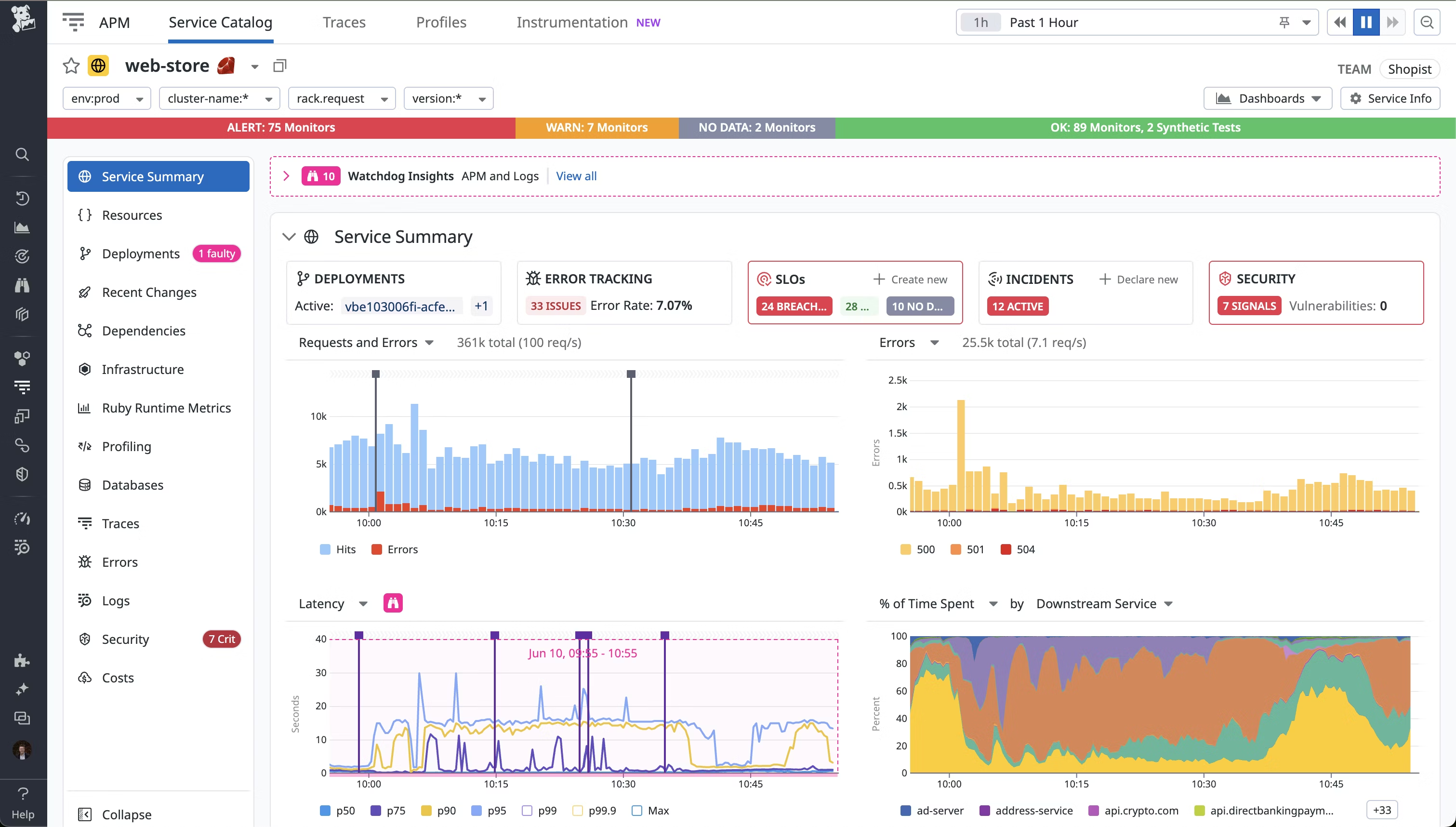
Key features:
- Full-Stack Visibility: Datadog unifies metrics, logs, traces, and events. You can correlate infrastructure metrics with traces and logs on a single dashboard.
- Extensive Integrations: Datadog connects directly to your AWS account and collects CloudWatch metrics, CloudTrail events, and AWS resource tags. It automatically pulls telemetry from services like EC2, Lambda, RDS, and ECS. You get prebuilt dashboards and the ability to filter data by region, instance ID, or custom tags.
- APM and Tracing: Datadog APM provides code-level performance profiling, distributed tracing, and transaction monitoring. It automatically instruments frameworks to capture web requests, database queries, and external calls.
- Real-Time Log Collection: Ingest CloudWatch Logs from Lambda, ECS, or EC2 with minimal setup. Datadog centralizes these logs and supports full-text search, filtering, and correlation with traces or metrics.
Pricing
Datadog's pricing is based on the number of hosts and the specific features utilised. For example, the APM service is priced at $31 per host per month. For more information, refer to Datadog's pricing.
Datadog uses a subscription-based model with usage-based components. Pricing varies by product:
- Infrastructure Monitoring: Priced per host, typically
15 per host per month for the Pro plan and23 per host per month for the Enterprise plan. This includes core metrics and integration data. - APM: Add-on priced per host, includes a trace allotment.
- Logs: Priced by data volume ingested, with additional costs for retention and rehydration. Typical pricing is
0.10 to0.25 per GB after the free quota.
Datadog offers a free tier (up to 5 hosts, 1-day retention) and a 14-day free trial. Pricing can be complex, especially for large-scale environments.
Ideal Use Cases
Datadog is best suited for organizations running cloud-native, microservices-based applications across AWS or hybrid environments. It is ideal for DevOps and SRE teams that require comprehensive, real-time observability across infrastructure and application stacks. The platform is especially effective for mid-sized to large enterprises that need a fully managed, scalable monitoring solution.
3. New Relic
New Relic is an observability and APM platform that helps you monitor applications and infrastructure end-to-end. The unified New Relic One platform consolidates metrics, events, logs, and traces to provide a comprehensive view of system performance.
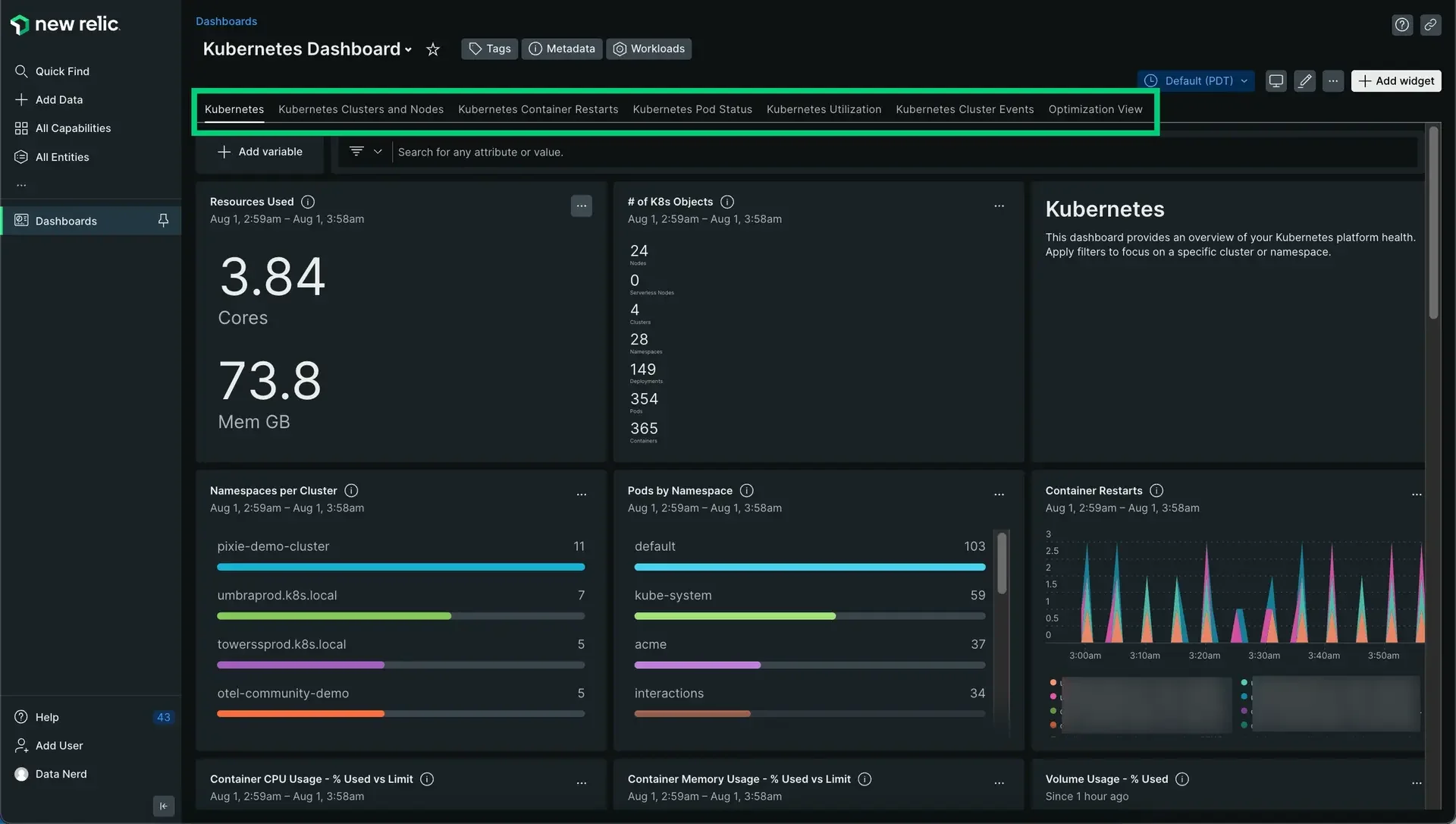
Key features:
- Full-Stack Observability: New Relic connects directly to your AWS account to collect CloudWatch metrics, CloudTrail events, and AWS resource tags. It correlates this data with application traces, infrastructure metrics, and logs. This gives you a single, unified view across your AWS environment and services.
- APM with Deep Code-Level Tracing: Instrument applications running on AWS (like Lambda, EC2, ECS, or EKS) with New Relic agents. You can trace individual transactions, identify slow database queries, and monitor key metrics like error rates and latency.
- Unified Telemetry: Ingest logs from CloudWatch and other sources, then correlate them with trace data and infrastructure metrics. For example, you can jump from a Lambda function error trace to the relevant log lines and EC2 host metrics.
- Alerts and AI-Powered Insights: Define alert conditions using AWS metrics, custom app metrics, or log patterns. New Relic's AI (Applied Intelligence and Grok) detects anomalies and noise-reduces alert storms by correlating related issues across your AWS infrastructure and applications.
- Quickstarts and AWS-Native Setup: Launch monitoring quickly using AWS CloudFormation templates, Lambda layers, or one-click quickstarts from the New Relic catalog. These include pre-built dashboards and alerts tailored for services like S3, DynamoDB, and API Gateway.
Pricing
Free Tier includes 1 full user with access to all features, unlimited basic users, and 100 GB/month of data ingestion.
You pay per GB after the free 100 GB/month. Prices range from ~0.25–0.50/GB depending on your plan. Full users cost approximately $99/user/month. New Relic charges based on data ingestion and user seats. For more information, refer to New Relic's pricing.
Ideal Use Cases
New Relic works best for application-centric monitoring. It's well suited for development teams and SREs who need detailed insights into web, API, and mobile app performance. It supports cloud and hybrid environments, including AWS. Organizations with dynamic workloads or short-lived infrastructure benefit from its usage-based pricing model.
4. Dynatrace
Dynatrace is an observability platform that uses automation and AI to provide full-stack monitoring. It covers infrastructure, APM, logs, user experience, and more. Dynatrace is well-suited for large, complex environments that require automation at scale.
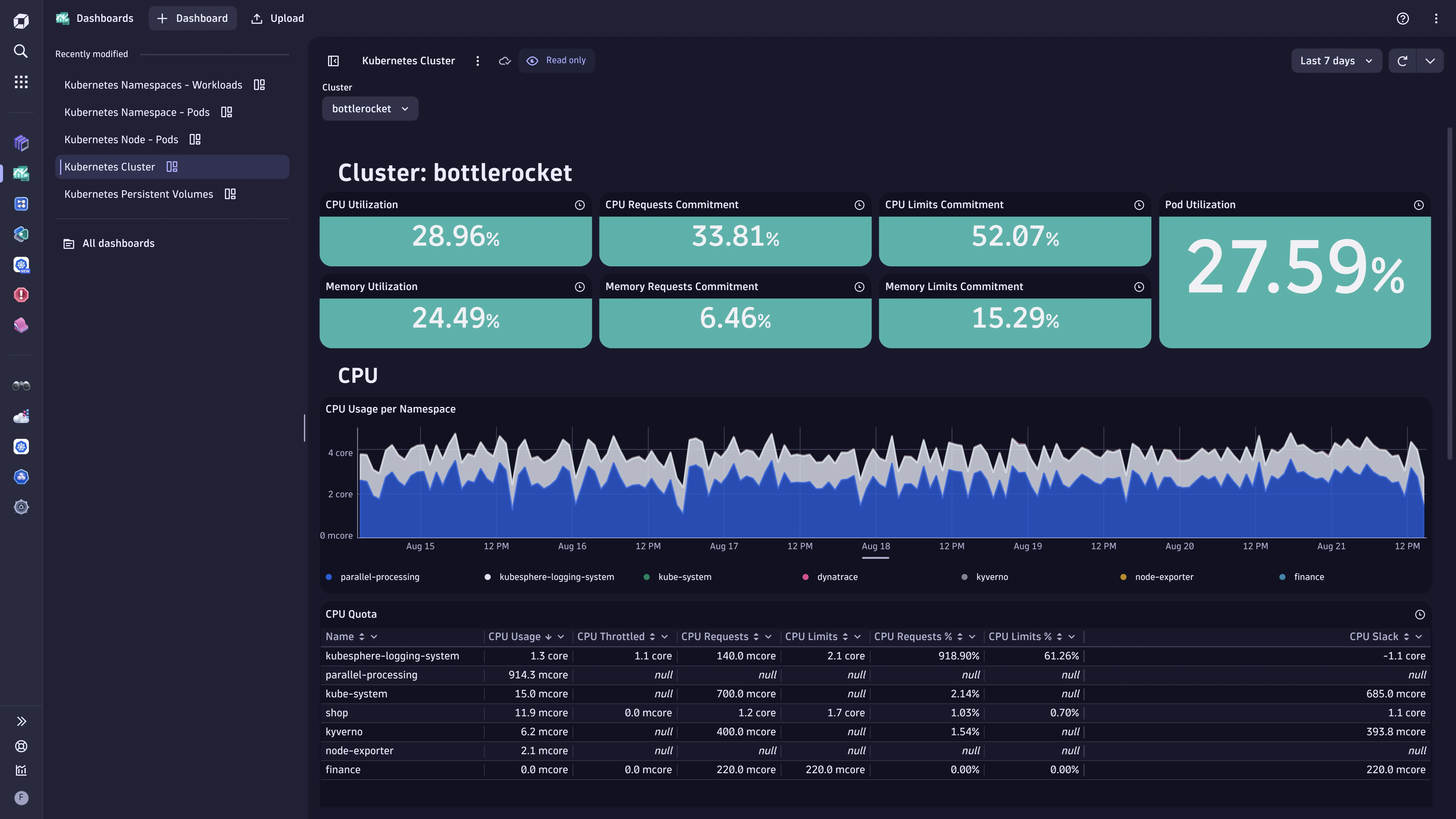
image credit: Dynatrace blog.
Key features:
- Automatic Instrumentation: Dynatrace uses a single agent to automatically discover apps and services. It injects instrumentation to collect metrics, traces, process topology, and method-level performance data without manual code changes. This reduces setup time and simplifies APM deployment.
- AI-Powered Root Cause Analysis: Dynatrace’s Davis AI detects anomalies and identifies root causes by analyzing service dependencies. When an issue occurs, Davis highlights the most probable cause, helping you troubleshoot faster and reduce alert fatigue.
- Cloud and Container Monitoring: Dynatrace provides deep support for Kubernetes, containers, and serverless workloads. It auto-injects into pods and integrates with orchestration platforms to track dynamic environments.
- AWS Integration: Dynatrace integrates with AWS in following ways:
- CloudWatch Metrics: Dynatrace pulls CloudWatch metrics after linking an AWS account. It includes services like S3 and DynamoDB in its AI-driven analysis.
- OneAgent Deployment on AWS: You can deploy OneAgent to AWS compute services using Systems Manager or scripts. Once installed, OneAgent sends infrastructure and application data to Dynatrace.
- Service Recognition: Dynatrace identifies AWS services in traces.
Pricing
Dynatrace uses a tiered pricing model, typically based on Davis Data Units (DDUs) or per-host units:
- Full-Stack Monitoring: Priced per monitored host (default: 16 GB RAM per unit). Includes infrastructure and APM.
- Infrastructure-Only Monitoring: A lower-cost option that focuses on server metrics without APM.
- Digital Experience Monitoring: Priced per 1,000 user sessions or per synthetic test execution.
- Logs: Log ingestion consumes DDUs based on data volume.
Dynatrace does not charge platform fees in full-stack editions. You pay based on usage (e.g., full-stack, infrastructure, or logs). For more information, refer to Dynatrace's pricing.
Ideal Use Cases
Dynatrace is ideal for large-scale microservice environments, such as Kubernetes clusters and service meshes. It helps enterprises automatically discover services and detect anomalies without manual setup. Organizations in finance, telecom, and tech use Dynatrace to reduce downtime and improve operational efficiency. It fits best where high availability, automation, and rapid troubleshooting are critical.
5. Sematext
Sematext is a unified monitoring and log management platform designed for modern DevOps and SRE teams. It offers infrastructure monitoring, log management, and alerting. Sematext emphasizes flexibility, ease of use, and affordability, making it suitable for both startups and growing enterprises.
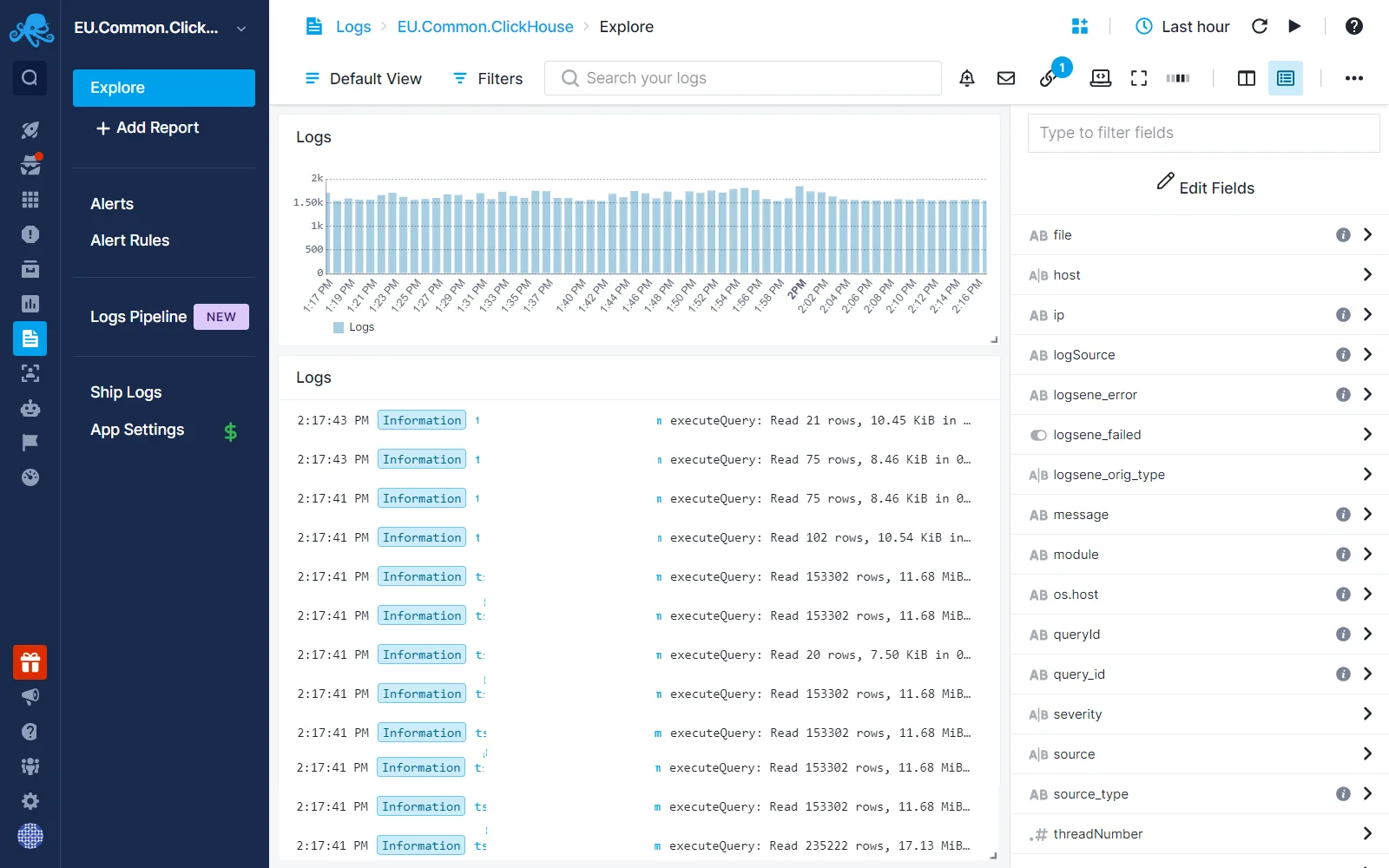
Image credit: Sematext documentation.
Key features:
- Infrastructure Monitoring: Sematext monitors servers, containers, and cloud instances. It collects metrics like CPU, memory, disk, and network usage, and provides prebuilt dashboards for common environments. It supports on-prem, cloud, and hybrid infrastructures.
- Log Management: Sematext Logs is a centralized log management solution that collects, parses, and indexes logs from various sources. It supports structured and unstructured logs, offers full-text search, and allows you to build alert rules and dashboards on top of log data.
- Container and Kubernetes Monitoring: Sematext supports Docker and Kubernetes monitoring out of the box. It collects container metrics, logs, and events and correlates them in unified dashboards. You can deploy the Sematext Agent as a DaemonSet in Kubernetes to monitor nodes, pods, and clusters with minimal setup.
- AWS Integration: Sematext integrates with AWS through CloudWatch and log shippers:
- CloudWatch Metrics: Pulls metrics for services like EC2, RDS, and S3 via IAM access.
- Log Shipping: Supports collecting logs from CloudWatch Logs and forwarding them to Sematext Logs.
- EC2 Agent: You can install the Sematext Agent on EC2 instances for detailed metrics, logs, and system-level events.
- Lambda and S3 Support: Collect logs from Lambda or push data from S3 via ingestion APIs or collectors.
Pricing
Sematext uses a modular pricing model based on selected features:
- Monitoring: Priced per host per hour. Includes infrastructure and container metrics.
- Logs: Priced based on volume of ingested data per day (e.g., 1 GB/day). Retention and search volume tiers affect pricing.
- Synthetics: Priced per HTTP or browser check. Includes global test locations.
Sematext offers a free tier with limited usage and supports pay-as-you-go billing. For more information, refer to Sematext’s pricing.
Ideal Use Cases
Sematext is ideal for small to mid-sized teams that need a unified observability platform without the complexity or high cost of enterprise solutions. It's especially useful for teams running Docker or Kubernetes, startups monitoring web applications, and developers looking for a simple log and metrics solution. Its modular pricing makes it accessible for gradual adoption and growth.
Conclusion
AWS cloud-native monitoring tools offer deep integration with AWS services and real-time insights for performance, operations, and security. These tools are ideal for teams operating entirely within AWS and needing seamless, automated monitoring aligned with AWS service usage.
Use AWS-native tools when:
- Your workloads are fully hosted on AWS.
- You require minimal setup and native service integration.
- You want to respond to AWS service events in real time (e.g., using EventBridge or CloudWatch Alarms).
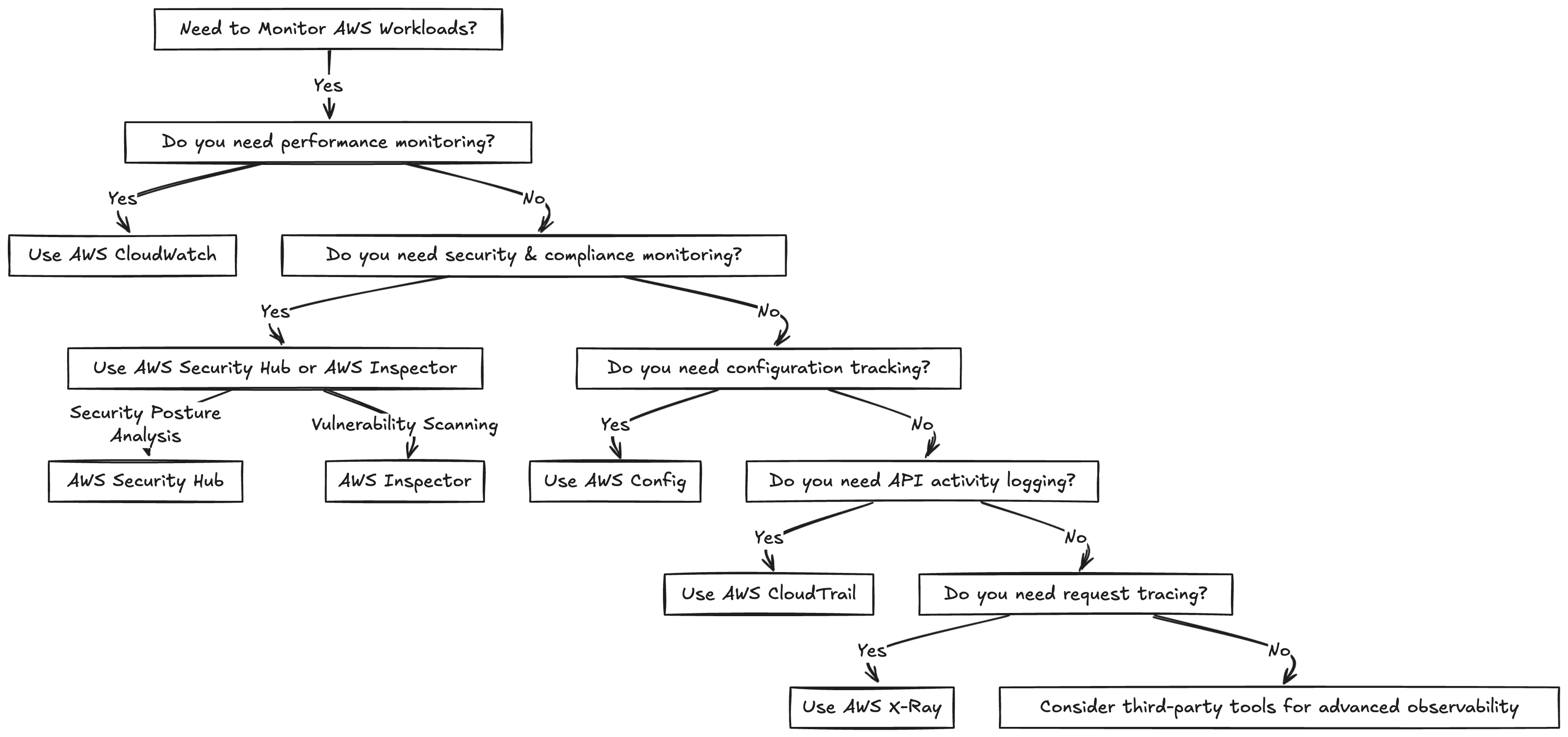
Use third-party tools when:
- Your architecture spans multiple clouds, hybrid environments, or includes on-premises components.
- You need richer visualizations, advanced correlation between logs, metrics, and traces, or machine learning–driven anomaly detection.
- You want unified monitoring across AWS and non-AWS systems (e.g., Kubernetes clusters, databases, CI/CD tools).
- You require more granular control over data retention, analytics, or custom alerting.
By combining AWS-native tools with third-party platforms, you gain both the seamless integration of AWS and the advanced features of external observability solutions, enabling end-to-end visibility, faster troubleshooting, and improved system reliability.
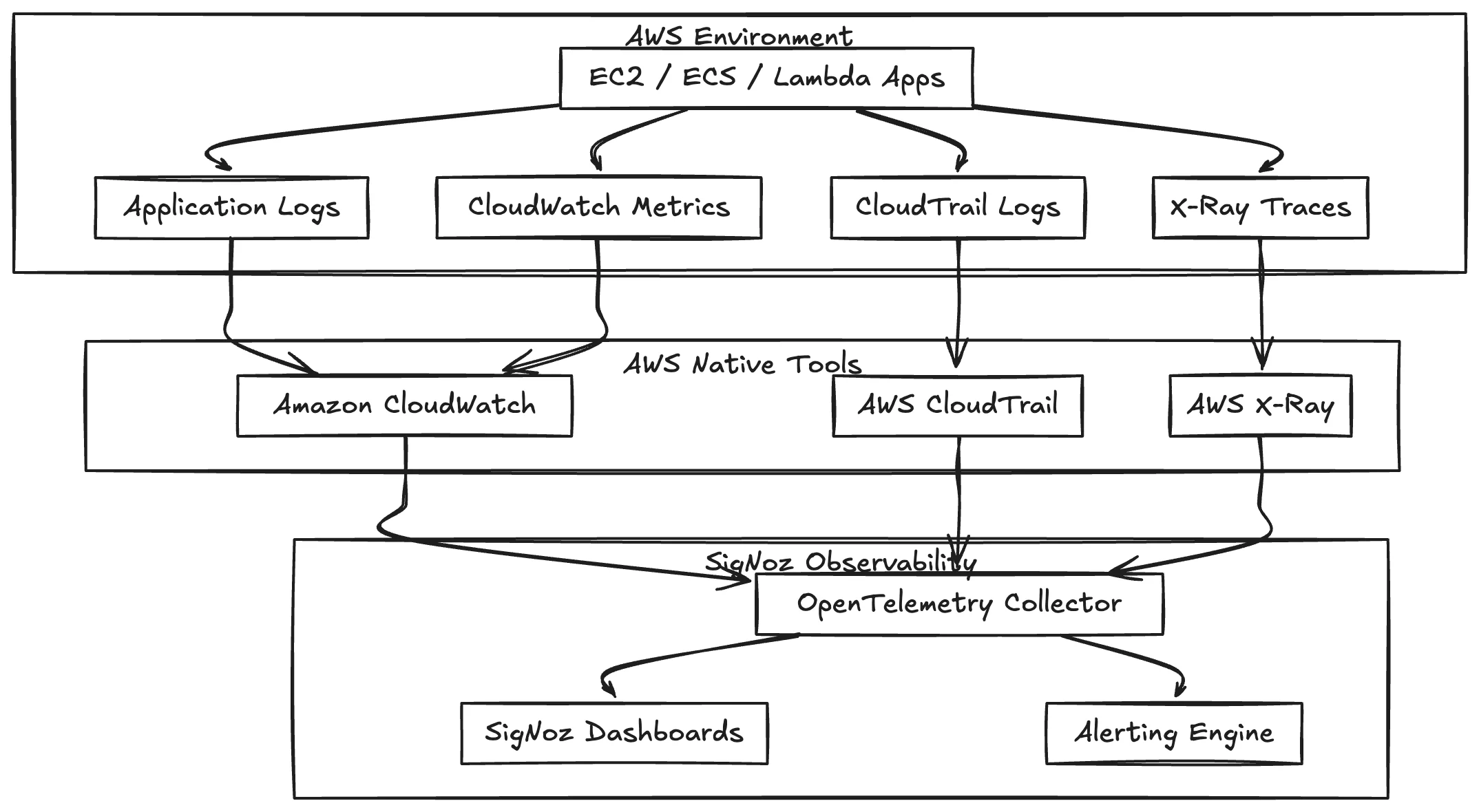
Benefits from a hybrid approach:
- Feed AWS-native telemetry into third-party platforms such as SigNoz, Datadog, or New Relic for centralized monitoring.
- Use AWS-native alerts to trigger incident response or automate remediation using AWS Lambda or EventBridge.
- Visualize AWS and non-AWS environments together by sending all observability data to a single third-party backend.
